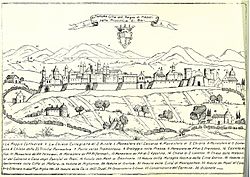| Altamura castle | |
|---|---|
|
Castello di Altamura | |
| Altamura, Apulia, Italy in Italy | |
 View of Altamura; 10 - Castello antico (the ancient castle) - Taken from Cesare Orlandi's book Delle città d'Italia (1770) | |
| Coordinates | Template:Coord/display/Castello di Altamura |
| Length | 67mx55m |
| Site information | |
| Open to the public | No |
| Condition | completely demolished |
| Site history | |
| Built | 11th-13th century |
| Built by | Norman (uncertain), Frederick II of the Holy Roman Empire |
| Garrison information | |
| Past commanders | Giovanni Antonio Del Balzo Orsini |
Altamura castle was a castle located in the city of Altamura, now completely demolished. It was located over today's piazza Matteotti and a few remains of it are still visible inside the adjacent buildings, which were built partly with stones and structural elements from the castle. In a warehouse is an ogival arch and some stone coats of arms. A few other remains are found in the adjacent buildings, which were built in the 19th century.[1]
The square on which stood the castle was previously named piazza Castello (which means "Castle square").[1] In Altamura dialect, the square is called u cuastidd (/ɯ kʷa'stɪdːᵊ/), which means "the castle".
History[]
The castle was probably built before Altamura was founded by king Frederick II (1243) and it was probably the seat of the feudal lord governing the nearby cluster of villages. Those villages were then displaced into the city right after the city was founded (1243). The proof that the castle was built before lies in some remains of the castle, that were visible until the demolition; Domenico Santoro (1688) wrote that there were insignia of Norman kings near the windows of the castle's church.[2] The castle was for a long time home to the "Altamura" family - the descendants of Sparano da Bari) - and it was the favorite residence of Giovanni Antonio Orsini Del Balzo, who was murdered therein in 1463.[3]
It also served as a prison. It is particularly well known for the imprisonment of prince Otto IV, husband to queen Joanna I of Naples.[4] Among the notables, Corrado Corradino was also imprisoned therein.[5]
The castle was abandoned in the late 15th century;[3] thereafter it slowly started to fall into pieces, so much that in 1642 it was already "uninhabitable and apparently likely to collapse".[6] The demolition date is not known, though it seems reasonable that it might have been demolished in the 19th century, as the castle occurs in many 18th century drawings.[7]
In the 20th century, part of the foundations appeared during some construction works on the square. Unfortunately, the remains found were destroyed and not even a sketch of the foundations was drawn up.[1]
Structure and dimensions[]
The castle was located close to the city's medieval walls. Domenico Santoro (1688) mentioned a courtyard and church inside the castle. On the 18th century drawings and paintings are visible four big corner towers (consistently with other castles commissioned by Frederick II). In circa 1330, a new big circular tower was added right next to the city walls.[3]
The structure of the castle is likely to have been modified and adapted to the needs. A part of the structure built by the Norman kings may have been incorporated in the renovation works made by Frederick II on the occasion of the foundation of Altamura.[3]
In circa 1330, king Robert of Anjou added a big circular tower, on which the Anjou's coat of arms was prominent.[8]
Details about the dimensions are given mainly by a plan sketch drawn up by architect Donato Giannuzzi in the mid-18th century. The ground dimensions were 67 meters e 55 meters, while the internal courtyard was 38 meters long and 25 meters wide. The whole castle stretched up to today's via Santa Teresa, farther than the square itself.[9]
Archeological contraints[]
The presence of the castle's foundations reportedly may have thwarted the functional rehabilitation of the square, that should have become underground parking. Non-invasive solutions have been proposed, in order to avoid damaging the historic heritage hidden underneath the square.[10]
References[]
- ↑ 1.0 1.1 1.2 Berloco 1985 p. 50 - note n. 62
- ↑ Berloco 1985 p. 50
- ↑ 3.0 3.1 3.2 3.3 Berloco 1985 p. 50 - note n. 63
- ↑ Orlandi 1770 p. 400
- ↑ Orlandi 1770 p. 402
- ↑ Berloco 1985 p. 221 - Descrizione della città di Altamura - Registro dei fuochi - 1642
- ↑ http://www.altamuralive.it/rubriche/859/articolodett
- ↑ Berloco 1985 p. 51
- ↑ https://www.altamuralife.it/notizie/piazza-matteotti-e-la-storia-di-un-castello-sotto-il-suo-suolo/
- ↑ https://www.altamuralife.it/ireport/il-parcheggio-sotterraneo-in-piazza-matteotti-si/
Bibliography[]
- Berloco, Tommaso (1985). Storie inedite della città di Altamura. ATA - Associazione Turistica Altamurana Pro Loco.
- Orlandi, Cesare (1770). Delle città d'Italia e sue isole adjacenti [sic compendiose notizie - Tomo primo]. https://books.google.co.uk/books?id=KGUOAAAAQAAJ&pg=PA399&dq=Cesare+Orlandi+Altamura&hl=en&sa=X&redir_esc=y#v=onepage&q=Cesare%20Orlandi%20Altamura&f=false.
The original article can be found at Altamura Castle and the edit history here.